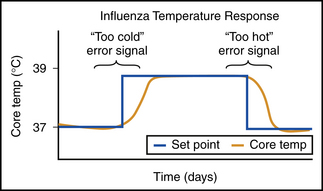68 CASE 68
Prior to today, the patient has been generally healthy and is up to date on all immunizations.
PATHOPHYSIOLOGY OF KEY SYMPTOMS
Influenza causes a transient increase in set point and, therefore, body core temperature. During the initial stages of the infection, temperature set point is elevated to 39°C. Body core temperature at 37°C is lower than the set point, and generating a “too cold” error signal, so heat gain mechanisms are activated. These include diminished cutaneous blood flow, shivering, and behavioral mechanisms such as putting on additional clothes or covering under blankets. Elevation of core temperature to 39°C brings the hypothalamic set point in body core temperature back into balance (Fig. 68-1).
< div class='tao-gold-member'>
Only gold members can continue reading. Log In or Register to continue
Stay updated, free articles. Join our Telegram channel

Full access? Get Clinical Tree



